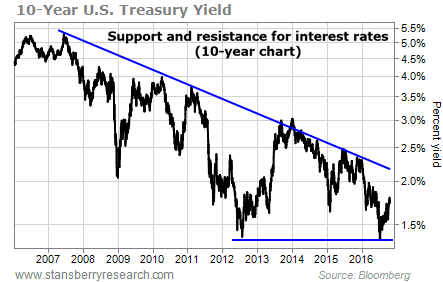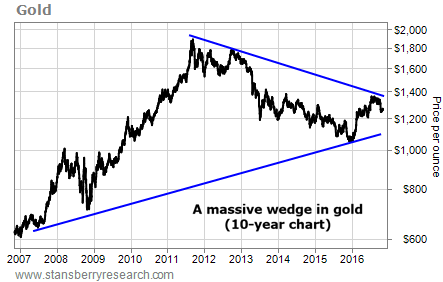Gold doesn’t trade in a vacuum.
Markets are connected. What happens in one often affects others.
[ad#Google Adsense 336×280-IA]So if you want to understand what’s happening with gold, you need to know what’s going on in the markets that affect gold.
And while lots of traders focus only on the short term, it’s important to have a big-picture view, too.
The big picture shows you the long-term trends at work… and when they change.
It can help you find low-risk opportunities to open new positions. And it can help you determine where to set your stops.
Today, we’ll look at the big picture for two markets that affect gold… along with gold itself.
Let’s get started…
The first market we’ll look at is U.S. government bonds… specifically, the yield on 10-year U.S. Treasurys. The U.S. government is considered the world’s safest borrower. (It can print money to pay lenders back, after all.) The rate it pays to borrow money for 10 years serves as the world’s benchmark interest rate.
Because gold doesn’t pay interest, it is less attractive when yields are high. So as yields rise and fall, the price of gold often (but not always) does the opposite.
The 10-year U.S. Treasury yield has been in a massive downtrend since the early 1980s. But it’s possible that the downtrend has finally ended. As you can see in the chart below, the 10-year yield hit 1.45% in 2012… And in early July of this year, it fell to 1.36%.
It was a new low. But it was close enough to the old one that the 1.4% area is now a strong support level for 10-year yields. The long-term downtrend line is a strong resistance level.

Right now, 10-year Treasurys yield 1.85%. It’s a little more than halfway between its support and resistance levels. If it breaks through resistance, there’s a good chance the long-term downtrend is over… and that interest rates around the world will start to rise. If it falls through support, even lower interest rates are likely ahead.
Watch the direction of the 10-year yield to get a better feel for what’s going on with gold. For example, if the 10-year yield rises, gold “should” fall. But if gold prices rise along with yields, it’s a great sign for the precious metal.
Next, we’ll look at the U.S. Dollar Index. The index measures the dollar against a basket of foreign currencies, like the euro, the Japanese yen, and the British pound. It’s a widely used gauge of the dollar’s global value.
Because we look at the price of gold in dollars, the value of the dollar itself is important. A more valuable dollar buys more gold… So a rising dollar can also be seen as a falling gold price. A weaker dollar buys less gold… So a falling dollar can also be seen a rising gold price. They’re two sides of the same coin, if you set aside all of the other factors that affect gold.
(Of course, because there are other factors, the dollar and gold can move in the same direction for extended periods of time.)
In the chart below, you can see that the dollar is trading in a big, sideways range…

If the dollar breaks higher (through resistance), it will put downward pressure on the price of gold. If it breaks lower (through support), it will put upward pressure on the price of gold.
Lately, the dollar has made a big run higher. Gold is down… but not too much. Again, that shows strength in gold.
Finally, let’s look at the big picture in gold itself. You already know that gold soared in the first half of the year… and that more recently, it has pulled back.
But when you zoom out to a 10-year chart, you’ll see that gold is near the middle of a massive wedge. Its resistance is a strong downtrend. And its support is a strong uptrend…

When a big wedge like this breaks, it’s significant. If you’re bullish on gold, a break through resistance at about $1,340 per ounce would be huge. It would be strong confirmation that a new bull market is indeed underway.
This move could happen in the first half of 2017… or possibly even sooner. If and when it does, you’ll want to have your shopping list ready.
Good trading,
Ben Morris
[ad#stansberry-ps]
Source: Growth Stock Wire
